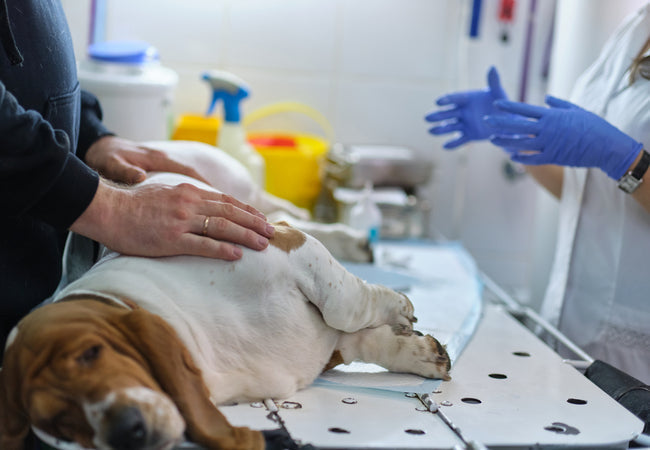Vet’s 2025 Guide to Canine Pyometra & Endometrial Hyperplasia Life-Saving Diagnosis & Treatment🩺

In this article
Vet’s 2025 Guide to Canine Pyometra & Endometrial Hyperplasia Life-Saving Diagnosis & Treatment🩺
By Dr. Duncan Houston BVSc
💡 What Are Pyometra & Endometrial Hyperplasia?
Cystic endometrial hyperplasia (CEH) is the thickening of the uterine lining with cyst formation due to repeated progesterone exposure. Pyometra is a life-threatening infection that follows when bacteria invade the cystic cavity, creating a pus-filled cavity. These conditions often occur together, commonly in older intact bitches.
⚠️ Why It Matters
- CEH creates an ideal environment for bacterial infection, leading to pyometra.
- Pyometra is an emergency—mortality is high if untreated, especially in closed form.
- Treatment options vary: surgery is fast; medical therapy is possible in select breeders.
🫁 Who Is at Risk?
- Unspayed females, typically 4–10+ years old; breeds vary.
- PCE therapy (progesterone/estrogen) further raises risk.
- Nulliparous dogs are at higher risk than those that have whelped.
🚩 Clinical Signs
Symptoms depend on whether the cervix is open or closed:
- Open pyometra: pus discharge from vulva, often odoriferous; systemic signs may be mild.
- Closed pyometra: no discharge, severe illness—anorexia, vomiting, PU/PD (urination/thirst), abdominal distension, weakness.
- Other signs: fever, dehydration, pale gums, lethargy.
🧪 Diagnostic Work-Up
- History & exam: intact female with uterine signs post-heat.
- Bloodwork: high WBC, elevated globulins, azotemia, low urine specific gravity.
-
Imaging:
- X-ray: enlarged fluid/gas-filled uterus, especially in closed pyometra.
- Ultrasound: distended uterine horns, echogenic/intraluminal fluid consistent with pyometra or CEH.
🩺 Treatment Options (2025 Standard)
1. Emergency Ovariohysterectomy (Spay) 🏥
- Gold standard—removes infected uterus and ovaries.
- Pre-op stabilization: IV fluids, broad-spectrum antibiotics (e.g., amoxiclav + enrofloxacin).
- Post-op care: Continue antibiotics for ≥14 days, recheck bloodwork.
2. Medical Management—Selective Use 🌱
- Reserved for breeders or poor anesthetic candidates.
- Drugs used:
- Prostaglandins (dinoprost/cloprostenol) to expel uterine contents.
- Progesterone antagonists (aglepristone) or dopamine agonists (cabergoline) to lower progesterone.
- Requires strict monitoring with daily ultrasound; stable open cervix cases only.
- Success rate is good in select cases; fertility outcome variable (14–92 %).
3. Supportive Care for All Dogs
- IV fluids for dehydration and shock.
- Correct electrolyte imbalances, treat sepsis.
- Pain management as needed.
📅 Recovery & Long-Term Outlook
- With surgery: hospital stay 2–5 days; quick improvement in appetite and hydration.
- Medical: requires close monitoring, slower recovery; may recur—about 20 % risk.
- Closed pyometra complications: uterine rupture, peritonitis, kidney failure, death if untreated.
- Spaying eliminates recurrence; medical therapy may preserve breeding potential but carries risk.
🏡 Ask A Vet Home Support
- Track appetite, vomiting, discharge, drinking/urination daily.
- Reminders: meds, rechecks, ultrasound follow-ups.
- Photo logging: vulva discharge, abdominal swelling.
- Alerts for fever, lethargy, anorexia, recurrent bleeding.
- Reminders for spay scheduling and breeding consultation.
🔍 Key Takeaways
- CEH is common in older intact bitches and often precedes pyometra.
- Pyometra is a surgical emergency—spaying plus stabilization saves lives.
- Medical treatment is a possible option for breeders, with careful case selection.
- Prompt treatment is vital—untreated cases can quickly become fatal, especially in closed pyometra.
- At-home monitoring via Ask A Vet keeps recovery on track and relapse rare.
🩺 Final Word ❤️
Pyometra in dogs is a serious but treatable disease, especially when diagnosed early and managed properly. In 2025, veterinary care combines emergency surgery, refined medical options for breeders, and personalized home-care monitoring with Ask A Vet. Together, we ensure safer recoveries, fewer relapses, and healthier lives for our beloved bitches. 🐾✨
Visit AskAVet.com and download the Ask A Vet app to track symptoms, medications, breeding decisions, follow-up scans, and stay connected with your vet—anytime, anywhere. 📲






